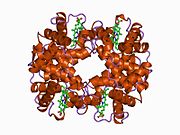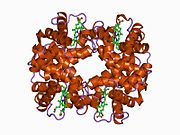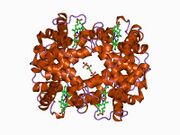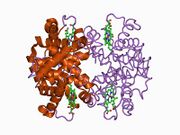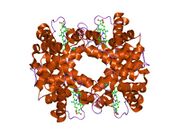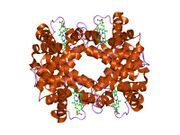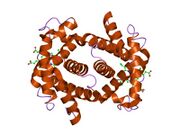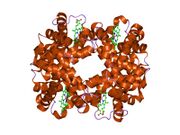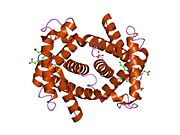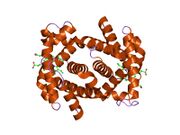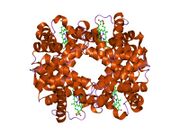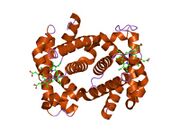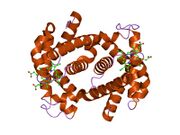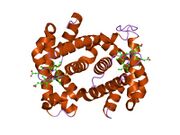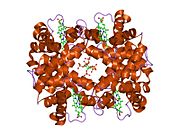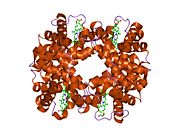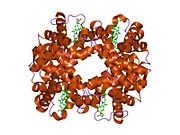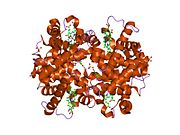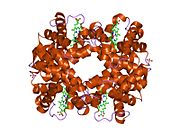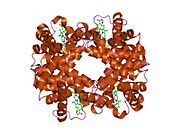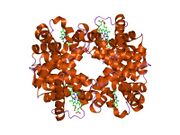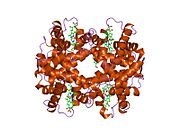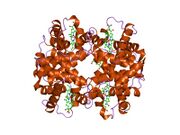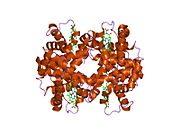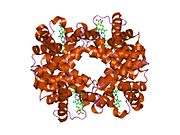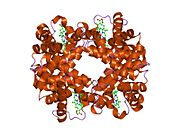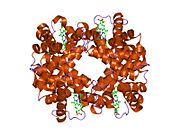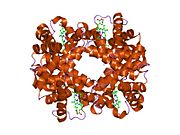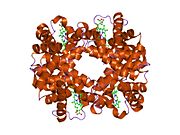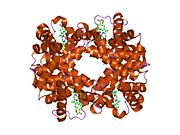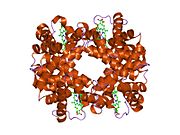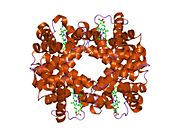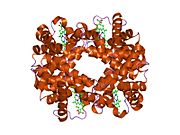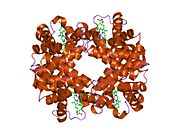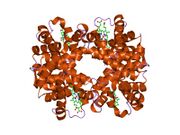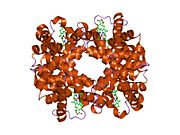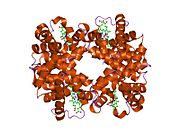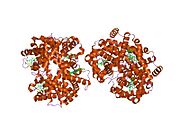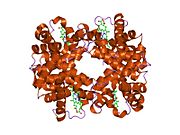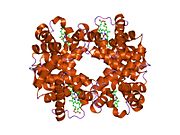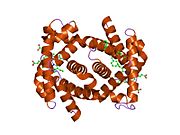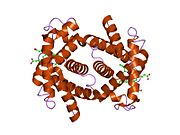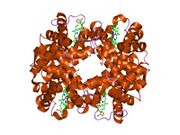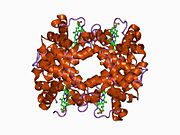Short description: Mammalian protein found in Homo sapiens
 Generic protein structure example |

In human, the HBB gene is located on chromosome 11 at position p15.5.
Beta globin (also referred to as HBB, β-globin, haemoglobin beta, hemoglobin beta, or preferably haemoglobin subunit beta) is a globin protein, which along with alpha globin (HBA), makes up the most common form of haemoglobin in adult humans, the HbA.[1] It is 147 amino acids long and has a molecular weight of 15,867 Da. Normal adult human HbA is a heterotetramer consisting of two alpha chains and two beta chains.
HBB is encoded by the HBB gene on human chromosome 11. Mutations in the gene produce several variants of the proteins which are implicated with genetic disorders such as sickle-cell disease and beta thalassemia, as well as beneficial traits such as genetic resistance to malaria.[2][3]
Gene locus
HBB protein is produced by the gene HBB which is located in the multigene locus of β-globin locus on chromosome 11, specifically on the short arm position 15.4. Expression of beta globin and the neighbouring globins in the β-globin locus is controlled by single locus control region (LCR), the most important regulatory element in the locus located upstream of the globin genes.[4] The normal allelic variant is 1600 base pairs (bp) long and contains three exons. The order of the genes in the beta-globin cluster is 5' - epsilon – gamma-G – gamma-A – delta – beta - 3'.[1]
Interactions
HBB interacts with Hemoglobin, alpha 1 (HBA1) to form haemoglobin A, the major haemoglobin in adult humans.[5][6] The interaction is two-fold. First, one HBB and one HBA1 combine, non-covalently, to form a dimer. Secondly, two dimers combine to form the four-chain tetramer, and this becomes the functional haemolglobin.[7]
Associated genetic disorders
Beta thalassemia
beta thalassemia is an inherited genetic mutation in one (Beta thalassemia minor) or both (Beta thalassemia major) of the Beta globin alleles on chromosome 11. The mutant alleles are subdivided into two groups: β0, in which no functional β-globin is made, and β+, in which a small amount of normal β-globin protein is produced. Beta thalassemia minor occurs when an individual inherits one normal Beta allele and one abnormal Beta allele (either β0, or β+). Beta thalassemia minor results in a mild microcytic anemia that is often asymptomatic or may cause fatigue and or pale skin. Beta thalassemia major occurs when a person inherits two abnormal alleles. This can be either two β+ alleles, two β0 alleles, or one of each. Beta thalassemia major is a severe medical condition. A severe anemia is seen starting at 6 months of age. Without medical treatment death often occurs before age 12. [8] Beta thalassemia major can be treated by lifelong blood transfusions or bone marrow transplantation.[9][10]
According to a recent study, the stop gain mutation Gln40stop in HBB gene is a common cause of autosomal recessive Beta- thalassemia in Sardinian people (almost exclusive in Sardinia). Carriers of this mutation show an enhanced red blood cell count. As a curiosity, the same mutation was also associated to a decrease in serum LDL levels in carriers, so the authors suggest that is due to the need of cholesterol to regenerate cell membranes.[11]
Sickle cell disease
More than a thousand naturally occurring HBB variants have been discovered. The most common is HbS, which causes sickle cell disease. HbS is produced by a point mutation in HBB in which the codon GAG is replaced by GTG. This results in the replacement of hydrophilic amino acid glutamic acid with the hydrophobic amino acid valine at the sixth position (β6Glu→Val). This substitution creates a hydrophobic spot on the outside of the protein that sticks to the hydrophobic region of an adjacent haemoglobin molecule's beta chain. This further causes clumping of HbS molecules into rigid fibers, causing "sickling" of the entire red blood cells in the homozygous (HbS/HbS) condition.[12] The homozygous allele has become one of the deadliest genetic factors,[13] whereas people heterozygous for the mutant allele (HbS/HbA) are resistant to malaria and develop minimal effects of the anaemia.[14]
Haemoglobin C
Sickle cell disease is closely related to another mutant haemoglobin called haemoglobin C (HbC), because they can be inherited together.[15] HbC mutation is at the same position in HbS, but glutamic acid is replaced by lysine (β6Glu→Lys). The mutation is particularly prevalent in West African populations. HbC provides near full protection against Plasmodium falciparum in homozygous (CC) individuals and intermediate protection in heterozygous (AC) individuals.[16] This indicates that HbC has stronger influence than HbS, and is predicted to replace HbS in malaria-endemic regions.[17]
Haemoglobin E
Another point mutation in HBB, in which glutamic acid is replaced with lysine at position 26 (β26Glu→Lys), leads to the formation of haemoglobin E (HbE).[18] HbE has a very unstable α- and β-globin association. Even though the unstable protein itself has mild effect, inherited with HbS and thalassemia traits, it turns into a life-threatening form of β-thalassemia. The mutation is of relatively recent origin suggesting that it resulted from selective pressure against severe falciparum malaria, as heterozygous allele prevents the development of malaria.[19]
Human evolution
Malaria due to Plasmodium falciparum is a major selective factor in human evolution.[3][20] It has influenced mutations in HBB in various degrees resulting in the existence of numerous HBB variants. Some of these mutations are not directly lethal and instead confer resistance to malaria, particularly in Africa where malaria is epidemic.[21] People of African descent have evolved to have higher rates of the mutant HBB because the heterozygous individuals have a misshaped red blood cell that prevent attacks from malarial parasites. Thus, HBB mutants are the sources of positive selection in these regions and are important for their long-term survival.[2][22] Such selection markers are important for tracing human ancestry and diversification from Africa.[23]
See also
References
Further reading
External links
- Overview of all the structural information available in the PDB for UniProt: P68871 (Human Hemoglobin subunit beta) at the PDBe-KB.
- Overview of all the structural information available in the PDB for UniProt: P02088 (Mouse Hemoglobin subunit beta-1) at the PDBe-KB.
PDB gallery |
|---|
1a00: HEMOGLOBIN (VAL BETA1 MET, TRP BETA37 TYR) MUTANT
1a01: HEMOGLOBIN (VAL BETA1 MET, TRP BETA37 ALA) MUTANT
1a0u: HEMOGLOBIN (VAL BETA1 MET) MUTANT
1a0z: HEMOGLOBIN (VAL BETA1 MET) MUTANT
1a3n: DEOXY HUMAN HEMOGLOBIN
1a3o: ARTIFICIAL MUTANT (ALPHA Y42H) OF DEOXY HEMOGLOBIN
1abw: DEOXY RHB1.1 (RECOMBINANT HEMOGLOBIN)
1aby: CYANOMET RHB1.1 (RECOMBINANT HEMOGLOBIN)
1aj9: R-STATE HUMAN CARBONMONOXYHEMOGLOBIN ALPHA-A53S
1b86: HUMAN DEOXYHAEMOGLOBIN-2,3-DIPHOSPHOGLYCERATE COMPLEX
1bab: HEMOGLOBIN THIONVILLE: AN ALPHA-CHAIN VARIANT WITH A SUBSTITUTION OF A GLUTAMATE FOR VALINE AT NA-1 AND HAVING AN ACETYLATED METHIONINE NH2 TERMINUS
1bbb: A THIRD QUATERNARY STRUCTURE OF HUMAN HEMOGLOBIN A AT 1.7-ANGSTROMS RESOLUTION
1bij: CROSSLINKED, DEOXY HUMAN HEMOGLOBIN A
1buw: CRYSTAL STRUCTURE OF S-NITROSO-NITROSYL HUMAN HEMOGLOBIN A
1bz0: HEMOGLOBIN A (HUMAN, DEOXY, HIGH SALT)
1bz1: HEMOGLOBIN (ALPHA + MET) VARIANT
1bzz: HEMOGLOBIN (ALPHA V1M) MUTANT
1c7b: DEOXY RHB1.0 (RECOMBINANT HEMOGLOBIN)
1c7c: DEOXY RHB1.1 (RECOMBINANT HEMOGLOBIN)
1c7d: DEOXY RHB1.2 (RECOMBINANT HEMOGLOBIN)
1cbl: THE 1.9 ANGSTROM STRUCTURE OF DEOXY-BETA4 HEMOGLOBIN: ANALYSIS OF THE PARTITIONING OF QUATERNARY-ASSOCIATED AND LIGAND-INDUCED CHANGES IN TERTIARY STRUCTURE
1cbm: THE 1.8 ANGSTROM STRUCTURE OF CARBONMONOXY-BETA4 HEMOGLOBIN: ANALYSIS OF A HOMOTETRAMER WITH THE R QUATERNARY STRUCTURE OF LIGANDED ALPHA2BETA2 HEMOGLOBIN
1cls: CROSS-LINKED HUMAN HEMOGLOBIN DEOXY
1cmy: THE MUTATION BETA99 ASP-TYR STABILIZES Y-A NEW, COMPOSITE QUATERNARY STATE OF HUMAN HEMOGLOBIN
1coh: STRUCTURE OF HAEMOGLOBIN IN THE DEOXY QUATERNARY STATE WITH LIGAND BOUND AT THE ALPHA HAEMS
1dke: NI BETA HEME HUMAN HEMOGLOBIN
1dxt: HIGH-RESOLUTION X-RAY STUDY OF DEOXY RECOMBINANT HUMAN HEMOGLOBINS SYNTHESIZED FROM BETA-GLOBINS HAVING MUTATED AMINO TERMINI
1dxu: HIGH-RESOLUTION X-RAY STUDY OF DEOXY RECOMBINANT HUMAN HEMOGLOBINS SYNTHESIZED FROM BETA-GLOBINS HAVING MUTATED AMINO TERMINI
1dxv: HIGH-RESOLUTION X-RAY STUDY OF DEOXY RECOMBINANT HUMAN HEMOGLOBINS SYNTHESIZED FROM BETA-GLOBINS HAVING MUTATED AMINO TERMINI
1fn3: CRYSTAL STRUCTURE OF NICKEL RECONSTITUTED HEMOGLOBIN-A CASE FOR PERMANENT, T-STATE HEMOGLOBIN
1g9v: HIGH RESOLUTION CRYSTAL STRUCTURE OF DEOXY HEMOGLOBIN COMPLEXED WITH A POTENT ALLOSTERIC EFFECTOR
1gbu: DEOXY (BETA-(C93A,C112G)) HUMAN HEMOGLOBIN
1gbv: (ALPHA-OXY, BETA-(C112G)DEOXY) T-STATE HUMAN HEMOGLOBIN
1gli: DEOXYHEMOGLOBIN T38W (ALPHA CHAINS), V1G (ALPHA AND BETA CHAINS)
1gzx: OXY T STATE HAEMOGLOBIN: OXYGEN BOUND AT ALL FOUR HAEMS
1hab: CROSSLINKED HAEMOGLOBIN
1hac: CROSSLINKED HAEMOGLOBIN
1hba: HIGH-RESOLUTION X-RAY STUDY OF DEOXYHEMOGLOBIN ROTHSCHILD 37BETA TRP-> ARG: A MUTATION THAT CREATES AN INTERSUBUNIT CHLORIDE-BINDING SITE
1hbb: HIGH-RESOLUTION X-RAY STUDY OF DEOXYHEMOGLOBIN ROTHSCHILD 37BETA TRP-> ARG: A MUTATION THAT CREATES AN INTERSUBUNIT CHLORIDE-BINDING SITE
1hbs: REFINED CRYSTAL STRUCTURE OF DEOXYHEMOGLOBIN S. I. RESTRAINED LEAST-SQUARES REFINEMENT AT 3.0-ANGSTROMS RESOLUTION
1hco: THE STRUCTURE OF HUMAN CARBONMONOXY HAEMOGLOBIN AT 2.7 ANGSTROMS RESOLUTION
1hdb: ANALYSIS OF THE CRYSTAL STRUCTURE, MOLECULAR MODELING AND INFRARED SPECTROSCOPY OF THE DISTAL BETA-HEME POCKET VALINE67(E11)-THREONINE MUTATION OF HEMOGLOBIN
1hga: HIGH RESOLUTION CRYSTAL STRUCTURES AND COMPARISONS OF T STATE DEOXYHAEMOGLOBIN AND TWO LIGANDED T-STATE HAEMOGLOBINS: T(ALPHA-OXY)HAEMOGLOBIN AND T(MET)HAEMOGLOBIN
1hgb: HIGH RESOLUTION CRYSTAL STRUCTURES AND COMPARISONS OF T STATE DEOXYHAEMOGLOBIN AND TWO LIGANDED T-STATE HAEMOGLOBINS: T(ALPHA-OXY)HAEMOGLOBIN AND T(MET)HAEMOGLOBIN
1hgc: HIGH RESOLUTION CRYSTAL STRUCTURES AND COMPARISONS OF T STATE DEOXYHAEMOGLOBIN AND TWO LIGANDED T-STATE HAEMOGLOBINS: T(ALPHA-OXY)HAEMOGLOBIN AND T(MET)HAEMOGLOBIN
1hho: STRUCTURE OF HUMAN OXYHAEMOGLOBIN AT 2.1 ANGSTROMS RESOLUTION
1ird: Crystal Structure of Human Carbonmonoxy-Haemoglobin at 1.25 A Resolution
1j3y: Direct observation of photolysis-induced tertiary structural changes in human hemoglobin; Crystal structure of alpha(Fe)-beta(Ni) hemoglobin (laser photolysed)
1j3z: Direct observation of photolysis-induced tertiary structural changes in human haemoglobin; Crystal structure of alpha(Fe-CO)-beta(Ni) hemoglobin (laser unphotolysed)
1j40: Direct observation of photolysis-induced tertiary structural changes in human haemoglobin; Crystal structure of alpha(Ni)-beta(Fe-CO) hemoglobin (laser unphotolysed)
1j41: Direct observation of photolysis-induced tertiary structural changes in human haemoglobin; Crystal structure of alpha(Ni)-beta(Fe) hemoglobin (laser photolysed)
1j7s: Crystal Structure of deoxy HbalphaYQ, a mutant of HbA
1j7w: Crystal structure of deoxy HbbetaYQ, a site directed mutant of HbA
1j7y: Crystal structure of partially ligated mutant of HbA
1jy7: THE STRUCTURE OF HUMAN METHEMOGLOBIN. THE VARIATION OF A THEME
1k0y: X-ray Crystallographic Analyses of Symmetrical Allosteric Effectors of Hemoglobin. Compounds Designed to Link Primary and Secondary Binding Sites
1k1k: Structure of Mutant Human Carbonmonoxyhemoglobin C (beta E6K) at 2.0 Angstrom Resolution in Phosphate Buffer.
1kd2: Crystal Structure of Human Deoxyhemoglobin in Absence of Any Anions
1lfl: DEOXY HEMOGLOBIN (90% RELATIVE HUMIDITY)
1lfq: OXY HEMOGLOBIN (93% RELATIVE HUMIDITY)
1lft: OXY HEMOGLOBIN (90% RELATIVE HUMIDITY)
1lfv: OXY HEMOGLOBIN (88% RELATIVE HUMIDITY)
1lfy: OXY HEMOGLOBIN (84% RELATIVE HUMIDITY)
1lfz: OXY HEMOGLOBIN (25% METHANOL)
1ljw: Crystal Structure of Human Carbonmonoxy Hemoglobin at 2.16 A: A Snapshot of the Allosteric Transition
1m9p: Crystalline Human Carbonmonoxy Hemoglobin C Exhibits The R2 Quaternary State at Neutral pH In The Presence of Polyethylene Glycol: The 2.1 Angstrom Resolution Crystal Structure
1mko: A Fourth Quaternary Structure of Human Hemoglobin A at 2.18 A Resolution
1nej: Crystalline Human Carbonmonoxy Hemoglobin S (Liganded Sickle Cell Hemoglobin) Exhibits The R2 Quaternary State At Neutral pH In The Presence Of Polyethylene Glycol: The 2.1 Angstrom Resolution Crystal Structure
1nih: Structure of deoxy-quaternary haemoglobin with liganded beta subunits
1nqp: Crystal structure of Human hemoglobin E at 1.73 A resolution
1o1i: Cyanomet hemoglobin (A-GLY-C:V1M,L29F,H58Q; B,D:V1M,L106W)
1o1j: Deoxy hemoglobin (A-GLY-C:V1M,L29F,H58Q; B,D:V1M,L106W)
1o1k: Deoxy hemoglobin (A,C:V1M; B,D:V1M,V67W)
1o1l: Deoxy hemoglobin (A-GLY-C:V1M,L29W,H58Q; B,D:V1M)
1o1m: Deoxy hemoglobin (A-GLYGLYGLY-C:V1M,L29F,H58Q B,D:V1M,V67W)
1o1n: Deoxy hemoglobin (A-GLYGLYGLY-C:V1M,L29W; B,D:V1M)
1o1o: Deoxy hemoglobin (A,C:V1M,V62L; B,D:V1M,V67L)
1o1p: Deoxy hemoglobin (A-GLY-C:V1M; B,D:V1M,C93A,N108K)
1qi8: DEOXYGENATED STRUCTURE OF A DISTAL POCKET HEMOGLOBIN MUTANT
1qsh: MAGNESIUM(II)-AND ZINC(II)-PROTOPORPHYRIN IX'S STABILIZE THE LOWEST OXYGEN AFFINITY STATE OF HUMAN HEMOGLOBIN EVEN MORE STRONGLY THAN DEOXYHEME
1qsi: MAGNESIUM(II)-AND ZINC(II)-PROTOPORPHYRIN IX'S STABILIZE THE LOWEST OXYGEN AFFINITY STATE OF HUMAN HEMOGLOBIN EVEN MORE STRONGLY THAN DEOXYHEME
1qxd: Structural Basis for the Potent Antisickling Effect of a Novel Class of 5-Membered Heterocyclic Aldehydic Compounds
1qxe: Structural Basis for the Potent Antisickling Effect of a Novel Class of 5-Membered Heterocyclic Aldehydic Compounds
1r1x: Crystal structure of oxy-human hemoglobin Bassett at 2.15 angstrom
1r1y: Crystal structure of deoxy-human hemoglobin Bassett at 1.8 angstrom
1rps: Crystallographic Analysis of the Interaction of Nitric Oxide with Quaternary-T Human Hemoglobin. Hemoglobin exposed to NO under anerobic conditions
1rq3: Crystallographic Analysis of the Interaction of Nitric Oxide with Quaternary-T Human Deoxyhemoglobin, Deoxyhemoglobin
1rq4: Crystallographic Analysis of the Interaction of Nitric Oxide with Quaternary-T Human Hemoglobin, HEMOGLOBIN EXPOSED TO NO UNDER AEROBIC CONDITIONS
1rqa: Crystallographic Analysis of the Interaction of Nitric Oxide with Quaternary-T Human Hemoglobin. Beta W73E hemoglobin exposed to NO under anaerobic conditions
1rvw: R STATE HUMAN HEMOGLOBIN [ALPHA V96W], CARBONMONOXY
1sdk: CROSS-LINKED, CARBONMONOXY HEMOGLOBIN A
1sdl: CROSS-LINKED, CARBONMONOXY HEMOGLOBIN A
1shr: Crystal structure of ferrocyanide bound human hemoglobin A2 at 1.88A resolution
1si4: Crystal structure of Human hemoglobin A2 (in R2 state) at 2.2 A resolution
1thb: REFINEMENT OF A PARTIALLY OXYGENATED T STATE HAEMOGLOBIN AT 1.5 ANGSTROMS RESOLUTION
1uiw: Crystal Structures of Unliganded and Half-Liganded Human Hemoglobin Derivatives Cross-Linked between Lys 82beta1 and Lys 82beta2
1vwt: T STATE HUMAN HEMOGLOBIN [ALPHA V96W], ALPHA AQUOMET, BETA DEOXY
1xxt: The T-to-T High Transitions in Human Hemoglobin: wild-type deoxy Hb A (low salt, one test set)
1xy0: T-to-THigh Transitions in Human Hemoglobin: alphaK40G deoxy low-salt
1xye: T-to-THigh Transitions in Human Hemoglobin: alpha Y42A deoxy low salt
1xz2: wild-type hemoglobin deoxy no-salt
1xz4: Intersubunit Interactions Associated with Tyr42alpha Stabilize the Quaternary-T Tetramer but are not Major Quaternary Constraints in Deoxyhemoglobin: alphaY42A deoxyhemoglobin no-salt
1xz5: T-to-THigh Quaternary Transitions in Human Hemoglobin: alphaL91A deoxy low-salt
1xz7: T-to-THigh Quaternary Transitions in Human Hemoglobin: alphaR92A deoxy low-salt
1xzu: T-to-THigh Quaternary Transitions in Human Hemoglobin: alphaD94G deoxy low-salt
1xzv: T-to-THigh Quaternary Transitions in Human Hemoglobin: alphaP95A deoxy low-salt
1y09: T-to-T(High) Quaternary Transitions in Human Hemoglobin: alphaN97A deoxy low-salt
1y0a: T-to-THigh Quaternary Transitions in Human Hemoglobin: alphaY140A deoxy low-salt
1y0c: T-to-THigh Quaternary Transitions in Human Hemoglobin: alphaY140F deoxy low-salt
1y0d: T-to-THigh Quaternary Transitions in Human Hemoglobin: desArg141alpha deoxy low-salt
1y0t: T-to-T(High) Quaternary Transitions in Human Hemoglobin: betaV1M deoxy low-salt (1 test set)
1y0w: T-to-THigh quaternary Transitions in Human Hemoglobin: betaV1M deoxy low-salt (10 test sets)
1y22: T-To-T(High) quaternary transitions in human hemoglobin: betaV33A deoxy low-salt (1 test set)
1y2z: T-To-T(High) quaternary transitions in human hemoglobin: betaV34G deoxy low-salt (1 test set)
1y31: T-To-T(High) quaternary transitions in human hemoglobin: betaY35A deoxy low-salt (1 test set)
1y35: T-To-T(High) quaternary transitions in human hemoglobin: betaY35F deoxy low-salt (1 test set)
1y45: T-To-T(high) quaternary transitions in human hemoglobin: betaP36A deoxy low-salt (10 test sets)
1y46: T-To-T(High) quaternary transitions in human hemoglobin: betaW37Y deoxy low-salt (10 test sets)
1y4b: T-To-T(High) quaternary transitions in human hemoglobin: betaW37H deoxy low-salt (10 test sets)
1y4f: T-To-T(High) quaternary transitions in human hemoglobin: betaW37A deoxy low-salt (10 test sets)
1y4g: T-To-T(High) quaternary transitions in human hemoglobin: betaW37G deoxy low-salt (10 test sets)
1y4p: T-To-T(high) quaternary transitions in human hemoglobin: betaW37E deoxy low-salt (10 test sets)
1y4q: T-To-T(High) quaternary transitions in human hemoglobin: betaF42A deoxy low-salt (1 test set)
1y4r: T-To-T(High) quaternary transitions in human hemoglobin: betaF45A deoxy low-salt (1 test set)
1y4v: T-To-T(High) quaternary transitions in human hemoglobin: betaC93A deoxy low-salt (1 test set)
1y5f: T-To-T(High) quaternary transitions in human hemoglobin: betaL96A deoxy low-salt (1 test set)
1y5j: T-To-T(High) quaternary transitions in human hemoglobin: betaH97A deoxy low-salt (1 test set)
1y5k: T-To-T(High) quaternary transitions in human hemoglobin: betaD99A deoxy low-salt (10 test sets)
1y7c: T-To-T(High) quaternary transitions in human hemoglobin: betaP100A deoxy low-salt (1 test set)
1y7d: T-To-T(High) quaternary transitions in human hemoglobin: betaP100G deoxy low-salt (1 test set)
1y7g: T-To-T(high) quaternary transitions in human hemoglobin: betaN102A deoxy low-salt (1 test set)
1y7z: T-To-T(High) quaternary transitions in human hemoglobin: betaN108A deoxy low-salt (1 test set)
1y83: T-To-T(High) quaternary transitions in human hemoglobin: betaY145G deoxy low-salt (1 test set)
1y85: T-To-T(High) quaternary transitions in human hemoglobin: desHIS146beta deoxy low-salt
1y8w: T-To-T(High) quaternary transitions in human hemoglobin: alphaR92A oxy (2mM IHP, 20% PEG) (10 test sets)
1ydz: T-To-T(High) quaternary transitions in human hemoglobin: alphaY140F oxy (2MM IHP, 20% PEG) (1 test set)
1ye0: T-To-T(High) quaternary transitions in human hemoglobin: betaV33A oxy (2MM IHP, 20% PEG) (1 test set)
1ye1: T-To-T(High) quaternary transitions in human hemoglobin: betaY35A oxy (2MM IHP, 20% PEG) (1 test set)
1ye2: T-To-T(High) quaternary transitions in human hemoglobin: betaY35F oxy (2MM IHP, 20% PEG) (1 test set)
1yen: T-To-T(High) quaternary transitions in human hemoglobin: betaP36A oxy (2MM IHP, 20% PEG) (10 test sets)
1yeo: T-To-T(High) quaternary transitions in human hemoglobin: betaW37A OXY (10 test sets)
1yeq: T-To-T(High) quaternary transitions in human hemoglobin: betaW37Y OXY (10 test sets)
1yeu: T-To-T(High) quaternary transitions in human hemoglobin: betaW37G OXY (10 test sets)
1yev: T-To-T(High) quaternary transitions in human hemoglobin: betaW37E OXY (10 test sets)
1yff: STRUCTURE OF HUMAN CARBONMONOXYHEMOGLOBIN C (BETA E6K): TWO QUATERNARY STATES (R2 and R3) IN ONE CRYSTAL
1yg5: T-To-T(High) quaternary transitions in human hemoglobin: betaW37H OXY (2MM IHP, 20% PEG) (10 test sets)
1ygd: T-To-T(High) quaternary transitions in human hemoglobin: betaW37E alpha zinc beta oxy (10 TEST SETS)
1ygf: T-to-T(high) quaternary transitions in human hemoglobin: betaH97A oxy (2MM IHP, 20% PEG) (1 test set)
1yh9: T-to-T(High) quaternary transitions in human hemoglobin: HbA OXY (2MM IHP, 20% PEG) (10 test sets)
1yhe: T-To-T(High) quaternary transitions in human hemoglobin: HbA OXY (5.0MM IHP, 20% PEG) (10 test sets)
1yhr: T-To-T(High) quaternary transitions in human hemoglobin: HbA OXY (10.0MM IHP, 20% PEG) (10 test sets)
1yie: T-to-thigh quaternary transitions in human hemoglobin: betaW37A oxy (2.2MM IHP, 13% PEG) (1 test set)
1yih: T-to-T(High) quaternary transitions in human hemoglobin: betaP100A oxy (2.2MM IHP, 20% PEG) (1 test set)
1yvq: The low salt (PEG) crystal structure of CO Hemoglobin E (betaE26K) approaching physiological pH (pH 7.5)
1yvt: The high salt (phosphate) crystal structure of CO Hemoglobin E (Glu26Lys) at physiological pH (pH 7.35)
1yzi: A novel quaternary structure of human carbonmonoxy hemoglobin
2d5z: Crystal structure of T-state human hemoglobin complexed with three L35 molecules
2d60: Crystal structure of deoxy human hemoglobin complexed with two L35 molecules
2dn1: 1.25A resolution crystal structure of human hemoglobin in the oxy form
2dn2: 1.25A resolution crystal structure of human hemoglobin in the deoxy form
2dn3: 1.25A resolution crystal structure of human hemoglobin in the carbonmonoxy form
2h35: Solution structure of Human normal adult hemoglobin
2hbc: HIGH RESOLUTION X-RAY STRUCTURES OF MYOGLOBIN-AND HEMOGLOBIN-ALKYL ISOCYANIDE COMPLEXES
2hbd: HIGH RESOLUTION X-RAY STRUCTURES OF MYOGLOBIN-AND HEMOGLOBIN-ALKYL ISOCYANIDE COMPLEXES
2hbe: HIGH RESOLUTION X-RAY STRUCTURES OF MYOGLOBIN-AND HEMOGLOBIN-ALKYL ISOCYANIDE COMPLEXES
2hbf: HIGH RESOLUTION X-RAY STRUCTURES OF MYOGLOBIN-AND HEMOGLOBIN-ALKYL ISOCYANIDE COMPLEXES
2hbs: THE HIGH RESOLUTION CRYSTAL STRUCTURE OF DEOXYHEMOGLOBIN S
2hco: THE STRUCTURE OF HUMAN CARBONMONOXY HAEMOGLOBIN AT 2.7 ANGSTROMS RESOLUTION
2hhb: THE CRYSTAL STRUCTURE OF HUMAN DEOXYHAEMOGLOBIN AT 1.74 ANGSTROMS RESOLUTION
2hhd: OXYGEN AFFINITY MODULATION BY THE N-TERMINI OF THE BETA-CHAINS IN HUMAN AND BOVINE HEMOGLOBIN
2hhe: OXYGEN AFFINITY MODULATION BY THE N-TERMINI OF THE BETA CHAINS IN HUMAN AND BOVINE HEMOGLOBIN
3hhb: THE CRYSTAL STRUCTURE OF HUMAN DEOXYHAEMOGLOBIN AT 1.74 ANGSTROMS RESOLUTION
4hhb: THE CRYSTAL STRUCTURE OF HUMAN DEOXYHAEMOGLOBIN AT 1.74 ANGSTROMS RESOLUTION
6hbw: Crystal structure of deoxy-human hemoglobin beta6 glu->trp
|



